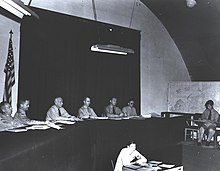Guam War Crimes Trials
The Guam War Crimes Trials were negotiations against members of the Imperial Japanese Army who had committed crimes against the customs of the war during the Pacific War . In the courts it was military tribunals ( military tribunal ) to the US model. Although the Navy also applied the "Regulations" of the Supreme Commander for the Allied Powers (SCAP) for war crimes trials of December 5, 1945, they reserved the right to adjust them if necessary.
organization
The judges were officers who had to be qualified to serve on an American court martial. Although one member was specifically to be appointed as a “law member”, none of the judges generally had any legal training. The tribunals usually had seven, no less than five, members, usually chaired by a rear admiral, more rarely a commodore or colonel of the marine infantry. The judgments of such tribunals did not have to be justified, so it is often not clear from the files why a particular judgment was pronounced in the respective form. The normally strict evidence assessment principles of the Anglo-Saxon legal system were not applied, but the rules were stricter than in the negotiations under the leadership of the SCAP , since the "Provisions for Naval Boards" were a procedural basis.
The indictment was represented by a " judge advocate " American model who - unlike his British colleague, who is a neutral advisor to the judges - acts as a public prosecutor. Evidence was collected from military units in the command area and evaluated by qualified legal personnel and processed into charges. One of the requirements was to bring only "watertight" charges to trial.
Was negotiated against accused as war of the category B or C (BC 級戦犯 were classified). American lawyers were added to them at state expense. The defendants were also allowed to call in Japanese lawyers they trusted. A comparatively high proportion of civilians were among the defendants.
Processes
In principle, the defense of having acted “on higher orders” was not recognized, but it could be considered as a mitigating circumstance. In 1946, the Minister of the Navy ordered that every death sentence for acts that had been carried out “by order of higher order” should be converted into a life sentence .
The first tribunal did not meet on December 7, 1945 in Guam, but at the US naval base in Kwajalein ( Marshall Islands ). Five Japanese naval officers were tried for the murder of three prisoners of war. Rear Admiral Masuda Nisuke committed suicide before the negotiations began and left a suicide note stating that he had ordered the execution of the three. Three of the remaining defendants were sentenced to death, and one prison guard was given ten years of forced labor.
In the trial against Lieutenant General Tachibana Yoshio and eleven others for the beheading of a prisoner of war in Chichi Jima ( Bonin Islands ) in February 1945 , the charge was murder. The general was also accused of cannibalism against the executed, which he also admitted. A conviction for this did not take place, however, since the "Procedures" - in contrast to those in Wewak for Australian processes - did not include jurisdiction over such a "primitive" crime. The defendants were only convicted of “neglect of duty against the fixed rules of humanitarian law ”. The officers were particularly accused of inadequately fulfilling their responsibilities as superiors.
After two months, the trial against the former commandant of the Naval Hospital on the Truk Islands came to an end in December 1947 . The main defendant, Iwanami Hiroshi , was charged with torturing eight American prisoners of war to death through human experimentation. He was sentenced to death by shooting, and the sentence was carried out. 18 other defendants received prison terms of ten years or more, one life sentence.
At the largest trial in Guam, 20 military personnel were charged with "barbarically slaughtering" ten civilians on the island of Babaelthuap ( Palau ). There were two acquittals.
In the proceedings against Rear Admiral Saikaibara Shigematsu u. a. There were eleven death sentences and five prison terms for the defendants involved in the 1943 murder of 98 Pan Am civilian employees on Wake Island .
Convictions
The trials came to an end by May 21, 1949. In a total of 47 negotiations, against a total of 123 accused, 113 convictions and 10 acquittals were made. Of those convicted, 30 (26.6%) were sentenced to death. Ten of these death sentences were carried out; excluding the commuted death sentences, there were 16 life imprisonment sentences.
Revision
All judgments were submitted for legal review to the Navy's Director War Crimes , who then made recommendations to the Pacific Fleet Commander and the Mariana Area Commander . The Navy's Judge Advocate General would then review the verdict against each individual convicted before submitting it to the Secretary of the Navy for final decision. A tightening of penalties in the revision process was excluded.
literature
- George Erickson: United States Navy War Crimes Trials (1945-1949) . In: Washburn Law Journal , Vol. 5 (1965), No. 4, pp. 97-99, ISSN 8750-7250 .
- Philip R. Piccigallo: The Japanese on Trial. Allied was crimes operations in the East. 1945–1951 . University of Texas Press, Austin TX et al. a. 1979, ISBN 0-292-78033-8 , pp 74-83.

